|
This year's San Francisco summer season combined the "Summer of Stein" with the "Summer of the Ring." Gertrude Stein and Richard Wagner, odd bed-fellows and yet, there they were, one of them at the museums with two epochal shows, the other at the opera house with the sixth-ever complete Ring Cycle at San Francisco Opera (the first one in 1935 with a stellar cast including Kirsten Flagstad and Laurence Melchior), heating up the atmosphere with equal excitement. Two geniuses who have a few things in common: a monumental ego and a monumental oeuvre; a provocative sexuality running through their work – lesbian for Stein and somewhat "queer" for Wagner; a gift for attracting controversy; ambivalence, in Stein's case, about her assimilated, upper-class Jewishness, and hysterical antisemitism in Wagner's. Wagner's antisemitism wasn't taken seriously by his contemporaries, Laurence Dreyfus reminds us in his elegant new study, Wagner and the Erotic Impulse (Harvard University Press). Wagner's tirades were considered ridiculous even by the likes of Theodor Herzl and Max Nordau, the founders of Zionism. With his effeminate passions for silk and lace (he wore pink satin underpants in order to compose), his heated romances with King Ludwig of Bavaria and other men, and the immoral and "degenerate" characters of his operas, Wagner was paradoxically seen as the epitome of what was considered "Jewish" by many of his contemporaries.
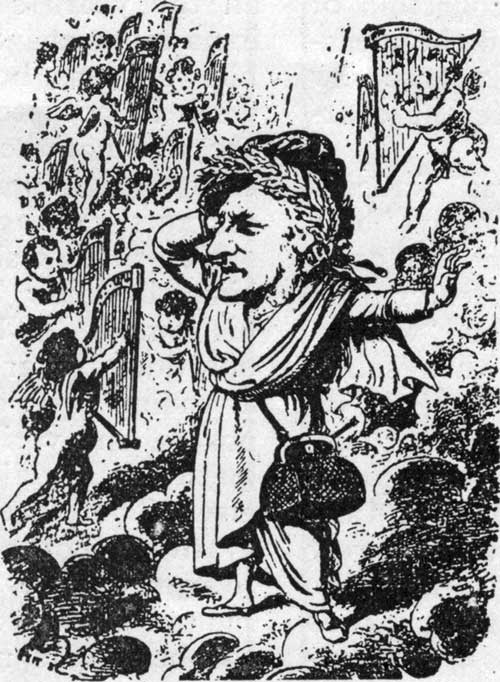 |
Looking back at the detailed production study of Patrice Chéreau's seminal Bayreuth 100-year anniversary Ring of 1976 (published in French and German), I was surprised that he took it for granted that the opponents of the Gods in the Ring -- the nordic-saga-based Nibelungs -- were disturbing Jewish sterotypes he had to try and get away from. Chéreau's is perhaps the unavoidable post-Hitler reading that projects antisemitism backwards all over the Wagner map. The dwarf Alberich as the ugly, power-greedy would-be lord of the world (Hitler's "international Jewish conspiracy for world domination") and his brother Mime as the despicable, hapless "Mauschel" or "Jid" -- this idea would not easily have occurred during Wagner's time. In the eyes of his admirers and even in those of his enemies (Nietzsche included in both) Wagner was notorious because of the sexual intensitiy of his music, not because of any antisemitic threats hidden in it. In "The Case Against Wagner" Nietzsche doesn't even mention antisemitism, and even after years of hatred for his one-time idol, upon hearing a new Wagner prelude, Nietzsche (quoted by Dreyfus) admired the "sublime and extraordinary feeling, … a synthesis of emotional states, (formed) with such acuitiy and insight that it slices into the soul as with a knife… Such artistry you only find in Dante, nowhere else."
The Ring's themes of love and power, its forces of good and evil, light and dark are archetypal like any world legend or creation myth. The 16-hour music-drama about gods and humans is in fact so universal it has been a ready projection screen for the artistic concerns of every epoch, whether with a pessimistic or optimistic bend. The very lack of ideology gives the Ring an openness that supports any modern and postmodern, political, spiritual, materialistic, apocalyptic, ecological or other fashionable "message."
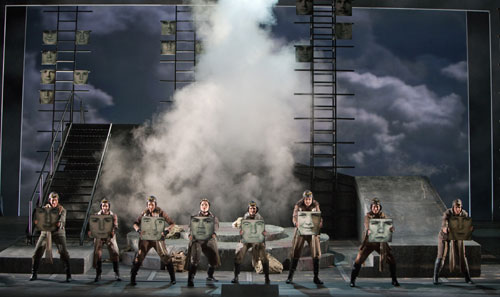 |
Interestingly, one could hardly get any further away from Chéreau's German-Jewish Ring dilemma than in Francesca Zambello's so-called "American" Ring. Her version already made me curious with its Gold Rush allusions and robber baron gods in Rheingold, in 2008. In 2010, Die Walküre showed great promise with its setting in the thirties, a skyscraper office for god Wotan as the CEO of the world, an irresistible tomboy-flapper Brünnhilde and parachuting, Amelia Ehrhardt look-alike Valkyries. Would the American concept hold water (to stay with the theme of the river Rhine)?
The answer is a resounding yes. Zambello, who worked on her Ring ideas for a decade, has created a brilliant, riveting American Der Ring des Nibelungen– a Ring that has it all: thrilling music under Donald Runnicle's baton, a first-class cast all the way through, consistently interesting stage sets by Michael Yeargan with inventive costumes by Catherine Zuber, beautiful and disturbing video projections by Jan Hartley, and most importantly, political and psychological relevance. "The parallels of our own contemporary story and those of the Ring came into focus for me in 2001," the director said. "I was working with David Gockley at Houston Grand Opera when ENRON exploded. We looked on in shock as the city collapsed, taking down the local men of myth and an economy built on avarice and math magic: bad deals, bad faith, bad banking, greed, and ambition on a colossal scale. We dwell in what sometimes seem like corresponding worlds in which Wotan gives up an eye to build a mansion he can't afford, and a young goddess provides eternal youth through negotiable apples of eternity – worlds in which man is out of balance with nature." The step-by-step destruction and despoiling of nature is compellingly shown in the video films that accompany the openings and interludes between acts and scenes, and reflected in the ever darkening sets.
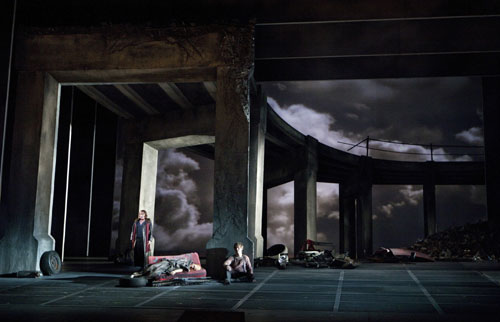 |
The cycle was performed three times in a row in Bayreuth style: each entire cycle in only 6 days. You are plunged into a drug-like musical stream like into the depth of the Rhine, hardly coming up for breath, into a cosmology where creation and destruction, heroism and doom depend on the suspenseful entanglements of one family of gods, heroes and antiheroes, men and women who intimately resemble us.
Also in the style of Bayreuth, where productions can be worked on and fine-tuned for up to five years, Zambello and her team had worked out many subtle changes between 2008 and now. Many new details added to the overall impact and most of the kinks I wrote about in these pages, had been ironed out. The gods of Rheingold were less silly and insignificant, for example, and better dressed. Siegmund and Sieglinde (good-looking Brandon Jovanovich and attractive Anja Kampe, both highly appealing singers) added a tad of glamour to the downtrodden clapboard hut in the woods in the first act of Die Walküre. Even slightly reducing the fussing and abject cowering of Sieglinde toward her brute of a husband (Daniel Sumegi as Hunding, lacking vocal threat) went a long way to help that weak scene. But Siegmund's death gained considerable dramatic intensity in the choreography, with Wotan stepping in just in time to let Siegmund die in his arms so his son could see him one last time. Mark Delavan's Wotan almost lost his voice during the final good-bye with his beloved daughter Brünnhilde, but held out heroically in almost sprechgesang (this was the second cycle), which did not ruin the powerful dialogue of separation between the god and the now mortal woman he kissed into magical sleep.
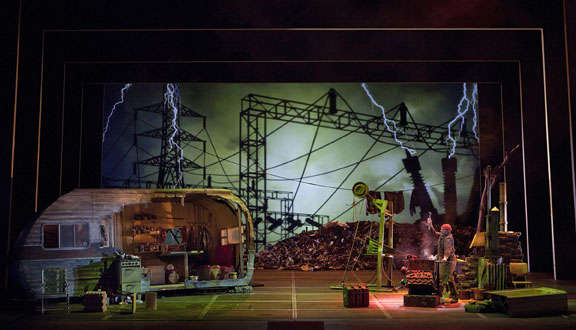 |
Part three of the cycle, Siegfried, is usually the most difficult nut to crack (and was the most dreaded by Chéreau). But Zambello pulled off a surprise winner. Time has spun forward to the devastated landscapes of American post-industrial urbanism. Nibelung Alberich, who cursed the ring of power when he lost it, is camouflaged as a homeless guy with a shopping cart amid urban rubble. His brother Mime has found refuge in a rotten trailer in the nowhere, living like white trash outside society. He has raised his orphaned ward, Siegmund and Sieglinde's son Siegfried, as a mixture between a spoiled, ill-mannered, moody American teen-ager and a wild-child. Mime is sung beautifully and acted out with irresistible aplomb and acrobatic agility by David Cangelosi who was applauded as the true "hero" of the night. Tenor Jay Hunter Morris as Siegfried has a lyrically ringing voice with just enough heft, a boyish look and body language. He wears a street kid's coat like some precursor of Jack Kerouac who will soon be on the road. Zambello gives him one tender reminiscence of his mother – the turquoise-blue sash from her dress in DieWalküre – the only remnant of beauty, femininity and cultivation. Whereas the long scenes featuring Mime often tend to be a test of patience one has to endure (even Chéreau failed here), Zambello gets so much entertainment and comedic humor out of her anti-hero and his counterpart that the endless teasing and mutual torturing and hammering at Siegfried's sword seem for once to fly by -- like a forest bird.
This forest bird for once appears onstage. When Siegfried gets to Fafner, the giant who guards Alberich's cursed ring, he arrives in an industrial warehouse desert that reeks of brutality and crime. Fafner has taken the shape of a dragon, translated by Zambello into a monstrous scrap metal compactor shooting light beams and steam. American boy Siegfried has had more than enough bad advice from old poppas like Mime; it makes perfect sense here that he ignores Fafner's warnings about taking the ring. In the same convincing way, a scene later, he disses god Wotan and smashes the spear, symbol of Wotan's world law. He is only interested in what the pretty bird -- the slender young woman all dressed in robin and cardinal reds (Stacey Tappan) -- has told him, gesturing to him from the metal rafters above Fafner's warehouse lair, singing about the most wondrous woman who sleeps on a rock ringed with fire – Brünnhilde. A number of critics resented this untraditional embodiment of the Forest Bird –but I saw it as one of the many enlivening links Zambello invented between the legendary, fairytale realm (spear and sword, cursed ring, magic potions, flying Valkyries etc.) and modern America. In the brooding shadows of the warehouse desert the illuminated woman in red had an effect like a painting by Edward Hopper.
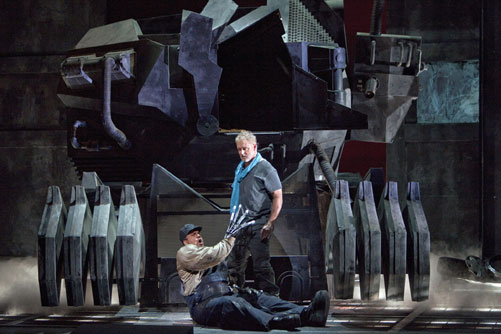 |
The last part of the cycle, Götterdämmerung (Twilight of the Gods,) opens with a similarly inspired idea. The three Norns (from Nordic legends), daughters of the Earth Goddess Erda, spin the threads of destiny and weave their mother's dreams inside a stage-filling computer, attached to the mother-board by "cables" that don't tear but "disconnect" when the twilight of the gods breaks. (The language of the supertitles supports the modern Americana whenever possible: Rhinegold, to give another example, is always "river gold.") With their sun glasses they could be black rap stars, dressed in the vibrant blue-green of a nature that has vanished from the world.
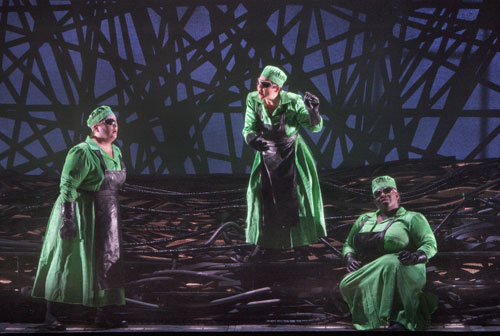 |
Siegfried, still wearing his blue-green sash of mother-memory as a scarf ( but now sung by tenor Ian Storey, who looks uncannily as if the same Siegfried had aged a few years), has been on the road to the wider world and we, the audience, have arrived in the "dome" of the vast architecture of Wagner's music. The Twilight of the Gods establishes the composer's full power after a work process of over twenty years. His mastery of the intricate language of motifs in ever-new allusions, boldly dissonant shadings, and echos of everything that came before, even allows for moments of "classic opera" quotations – a full chorus, moments of duets and trios.
Siegfried now enters the corrupt realm of the Gibichungs and Hagen (Andrea Silvestrelli), the son of Wotan's arch enemy Alberich. The clan could be modern day Texans in their nouveau-riche penthouse with leopard-patterned pillows and bar stools, overlooking poison-spewing refineries on the bank of the Rhine. Gunter (Gerd Grochowski) and Gutrune (Melissa Citro) are dominated by their half-brother Hagen's greed for power. Their Black Water-style private army stands ready to protect their name and wealth (superb choreography and singing makes the men's chorus a believable threat) -- just as Wotan created an army of dead heroes with the help of his Valkyries in order to defend his power.
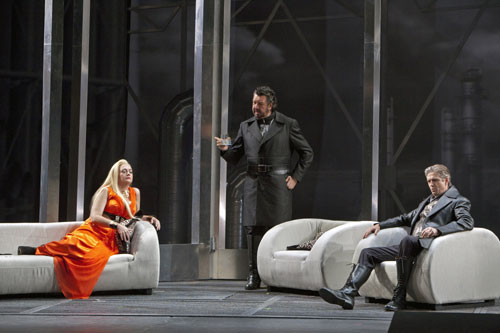 |
One misstep of the direction: Gutrune, the bait for Siegfried, a would-be Brigitte Bardot with her mane of platinum hair and risky d̩collet̩, is overplayed as a dumb blonde and minces on her heels like a bad caricature of a geisha. I am also not sure about Zambello's idea to invent another incestuous relationship, that of Gutrune and Hagen. It may make psychological sense as a negative reflection of the idealized twins (Siegmund and Sieglinde) whose heroic glory obsesses Hagen (the son Alberich begot by buying the favors of Gunter and Gutrune's mother), but the presence of Gutrune in Hagen's bedroom distracts and greatly weakens the crucial scene that follows, where Hagen in deep sleep is visited by Alberich Рa scene of uncanny foreboding of evil.
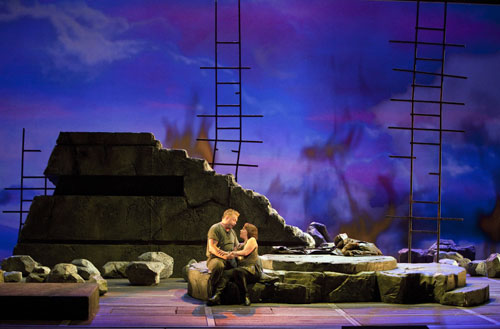 |
Meanwhile, Brünnhilde is left on her rock with nothing to comfort her other than Siegfried's ring – a strangely archetypal situation Wagner conceived that recalls the lonely Hausfrau whose husband has taken off on his adventures. With her clarion voice, laser-like top and the beautiful, rock-solid middle range that betrays her beginnings as a mezzo, Swedish soprano Nina Stemme continued her outstanding run in this first entire Ring cycle of her career. With her ageless tomboy demeanor, sturdy legs and elbows slightly akimbo as if always ready for a tussle, she convincingly acted the embarrassment and awkwardness of being a human who has to approach love as the sexual love of a woman. Now she unleashes heart-rending terror and indignation when Siegfried, taking the shape of Gunter, abducts her and robs her of the ring so he can wed Gutrune. Her humiliation, when she is presented at Gunter's court, bereft of all power, in the make-over of a hapless society lady in lavender, is as horrendous as her rage when she finds out how Siegfried betrayed her. With extraordinary vocal intensity she sets in motion her revenge, enticed by Hagen whose design of course has always been Siegfried's death and repossession of the Nibelung's ring.
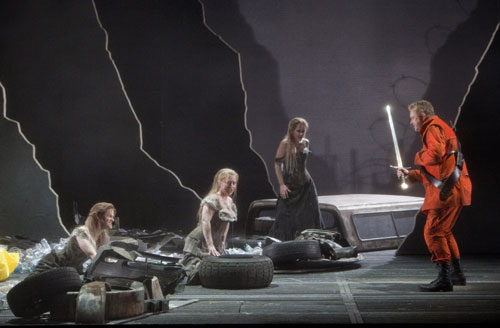 |
Wagner, the brilliant dramaturge, always gives his heroes and heroines another chance, keeping up the suspense. The Rhinemaidens, this time in an empty river bed, carrying plastic bags to collect garbage -- water bottles, broken furniture, even a car – offer to save Siegfried from his impending death in return for the ring he is still wearing – the ring that would restore the natural order if he returned it to the Rhine. But the innocent fool -- after all not so different from Alberich -- berates the women: "Women always come up with some threat when they don't get what they want."
After his murder by Hagen, Brünnhilde finally sees through all the manipulations, deceits, and power twists that started with Wotan and Alberich and ended with her as the victim – a victim who turns powerful when she realizes: "All this had to happen in order to bring wisdom to one woman…" Zambello now brings the end of the Ring into the realm of women. Women carry in the piles of wood for Brünnhilde's funeral pyre, the Rhinemaidens and the remorseful Gutrune form a solemn sisterhood for Brünnhilde's last act. The redemption of Brünnhilde's self-sacrifice is given a positive bend – staying American to the last note – when, in the last image, some men join the women on the river bank and a little girl plants a little tree. In the background the Gods go up in flames.
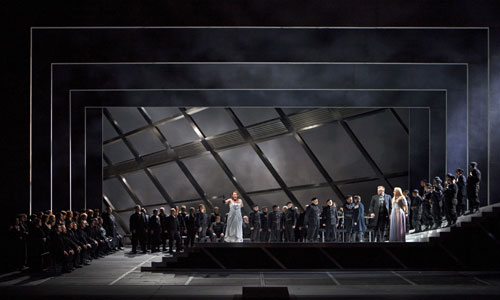 |
"Perhaps the most heartbreaking aspect of the Ring ," Zambello sums up the cycle, "is Wotan's failure to realize the perfect hero he so desires was actually his daughter Brünnhilde. I call her the hero rather than the heroine because she achieves in a sense what no man can achieve: returning the Ring to the Rhinemaidens and restoring a natural order."
The American Ring — in the end also a feminist Ring? This did not sit well with certain critics who bemoaned the loss of the dominant patriarchal Ring traditions, not aware apparently, that this interpretation is not only extremely timely, it is also just what Wagner had in mind. On the day of his death, in 1883, he was working on an essay titled, "On the Womanly in the Human," the continuation of a thought he already had in 1851, when he began conceiving his Ring. He noted that "true womanliness, which should one day bring redemption to me and to all the world, after male egoism, even in its noblest form, has obliterated itself before her."
The patriarchal Gods of the Ring have their twilight for good reason, as we have seen in 16 hours of a tremendously conherent, brilliantly inventive and moving production that places San Francisco Opera's "Summer of the Ring" at the very top of the Ring fashion in America.
Photos - Cory Weaver
|


